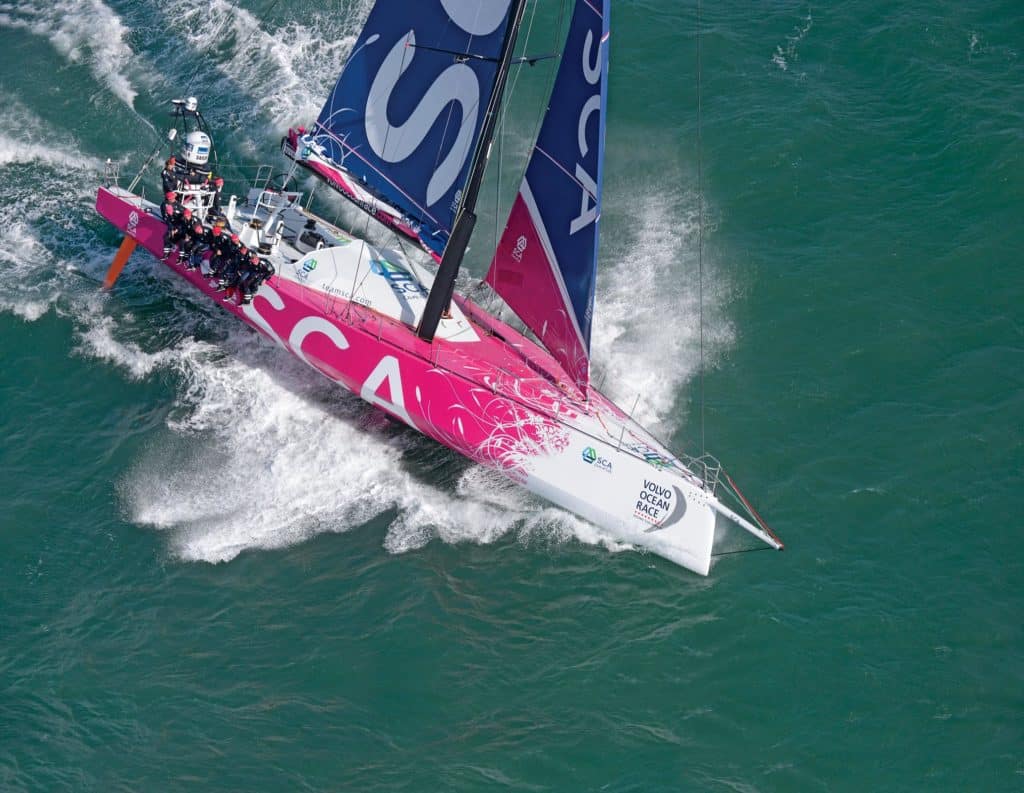When Farr Yacht Design drafted the Volvo Ocean Race’s new one-design, the mandate was simple: make it fast, make it powerful, and make it last. To live up to the race’s extreme status, the boat’s redline speeds had to be as good or better than its predecessor, the VO70.
Team SCA, the race’s all-female squad, got its hands on Hull No. 2 and promptly put the boat to the test, logging more than 20,000 miles in the past 10 months. Come race day, the ladies of Team SCA will have more experience behind the wheels of a VO65 than any other team, so trimmer/helmsman Sally Barkow, of Nashotah, Wis., knows full-well the thrill ride the boat can deliver. Barkow shares her thoughts on the 65-foot carbon sled that she will help drive around the globe.
The VO65 feels somewhere between the VO70 and a normal keelboat, but the acceleration and power are so much more. At top speeds, everything is fully loaded. It’s extremely wet, and extremely noisy. When you sheet on, sounds come fast: water rushing past the hull, winches grinding, pedestals turning, and people huffing and puffing. As the boat loads up, it heels quickly and spray instantly comes over the deck. And when you bear away, even just a few degrees to build speed, the sheets groan as they creep around the winch drums.
The jibs appear relatively small, but in 25 knots we’re pretty overpowered in our medium jib. We might put in a reef to keep the boat on its feet, which is most often between 20 and 30 degrees of heel. Managing this feels like being on a teeter-totter: We’re trying to hold onto the power to accelerate forward and releasing the power in the sails to get the boat back under control.
Out of a tack, we can feel the change in the boat’s behavior as the keel swings from 40 degrees, to centerline, and back to 40 degrees on the other side-that’s maximum cant angle. If the keel doesn’t get up in time, the underwater foils stall because everything, combined, above the waterline is very powerful relative to what’s below the waterline.
Adding water to the ballast tanks dampens the boat’s otherwise jerky motion. When there’s water in the aft tanks the transom drags a bit in the water and you can hear it bubbling. If there’s water in the forward tanks I can feel the bow digging into the waves, which makes it harder to drive through them.
Noise is ever present on the boat. When were crashing it’s extremely loud. The whole boat is shaking and there are violent slapping sounds as waves hit the exposed underbody of the hull. Even if we’re going upwind, up and down the waves, and not necessarily pounding through them, it’s incredibly loud below.
My goal when below is to be out of my bunk for no more than five minutes. Because all the boat’s motions are magnified below, and because you can’t see when the boat is about to launch off a wave, you can instantly be thrown clear across the boat.
We can feel when it’s out of control and too overpowered, and when it is, we must change the sail configuration. If we know there’s an increase in breeze coming we can go for the first reef, and if we’re already out of range we can change headsails and go in and out of reefs, based on what the wind forecast is. It’s a balance; we never want to be in the small jib with the full main, which isn’t a good combination. Surprisingly, we feel faster with the reef and that’s probably because there’s so much power up high.
With the daggerboards we can really feel the leeway when they’re in the wrong position. Daggerboard trim is critically important, though, because when they’re right, the percentage in speed increase is significant.
The fundamental challenge is trying to control the power. The helm is surprisingly light, even when we’re into the upper wind range. The magic comes when we crack off under the big kite. When that happens everyone’s aware it’s going to get wet, that we should be clipped in, and have everything set before we do it.
The lightness of the helm allows us to drive around a bit in flat water, but it’s much different in big waves. There’s a lot of windward helm when both rudders are in the water, but when there’s only one in-when we’re at 20 to 30 degrees of heel, the helm is light and very responsive. It gets tricky in big waves. We have to be aggressive on the helm sometimes to keep it under control and avoid wiping out. It all has to do with heel angle and power. If we heel quickly and we can’t get it to come back down we’re definitely going to wipe out. That’s why we’re aggressive with the wheel.
Night driving is incredibly difficult and requires a different level of focus. It’s purely a concentrated focus on the numbers. Sometimes it can be smooth and easy, while other nights it’s hard to keep the boat on the right angle. The race isn’t all about blast reaching though. There are slow moments that require more patience. Everything we can do to keep them going is critical. It’s a constant of playing with flow and smooth driving. If you do stop dead in the water you can easily lose steerage and keep everything you have all the time.










